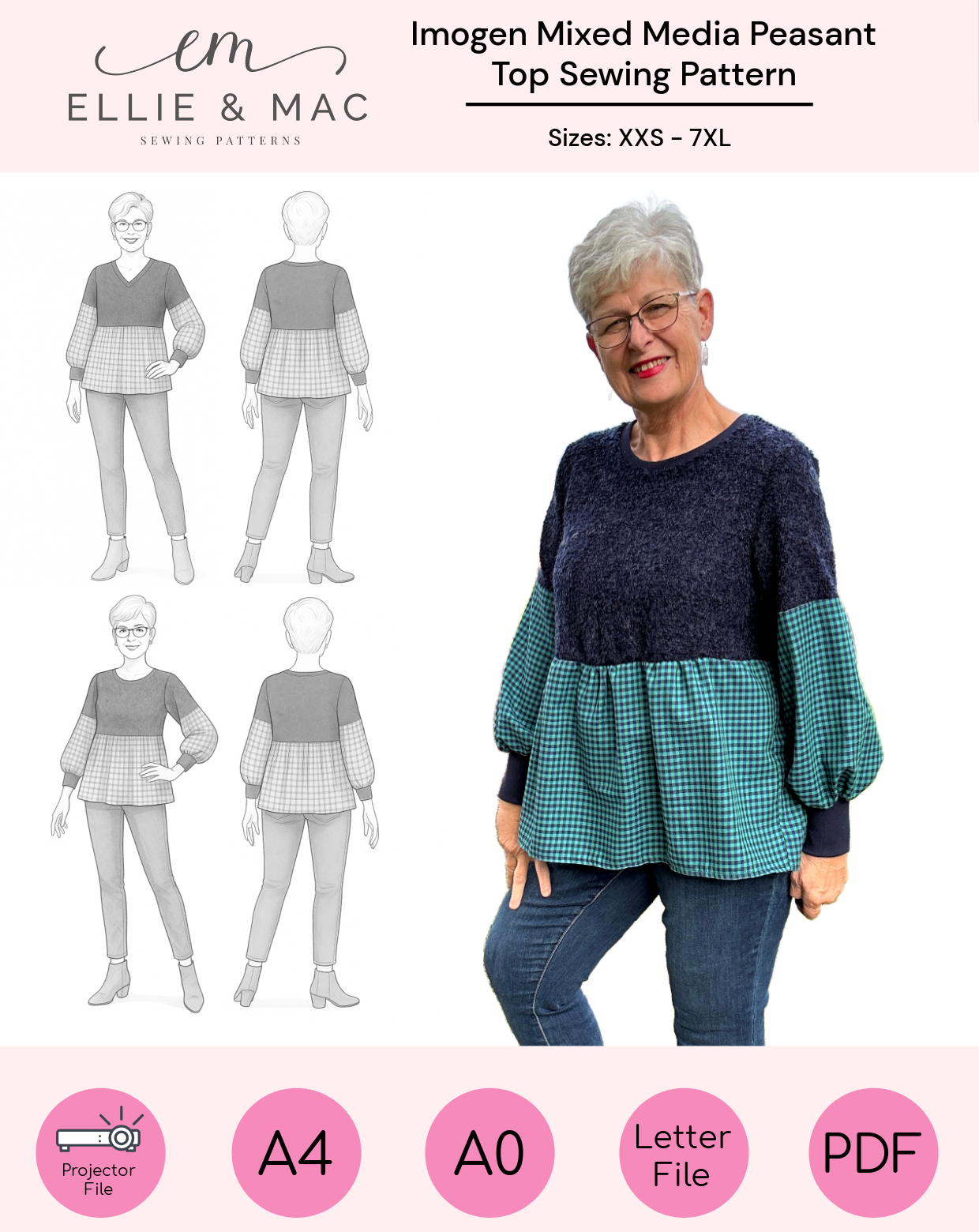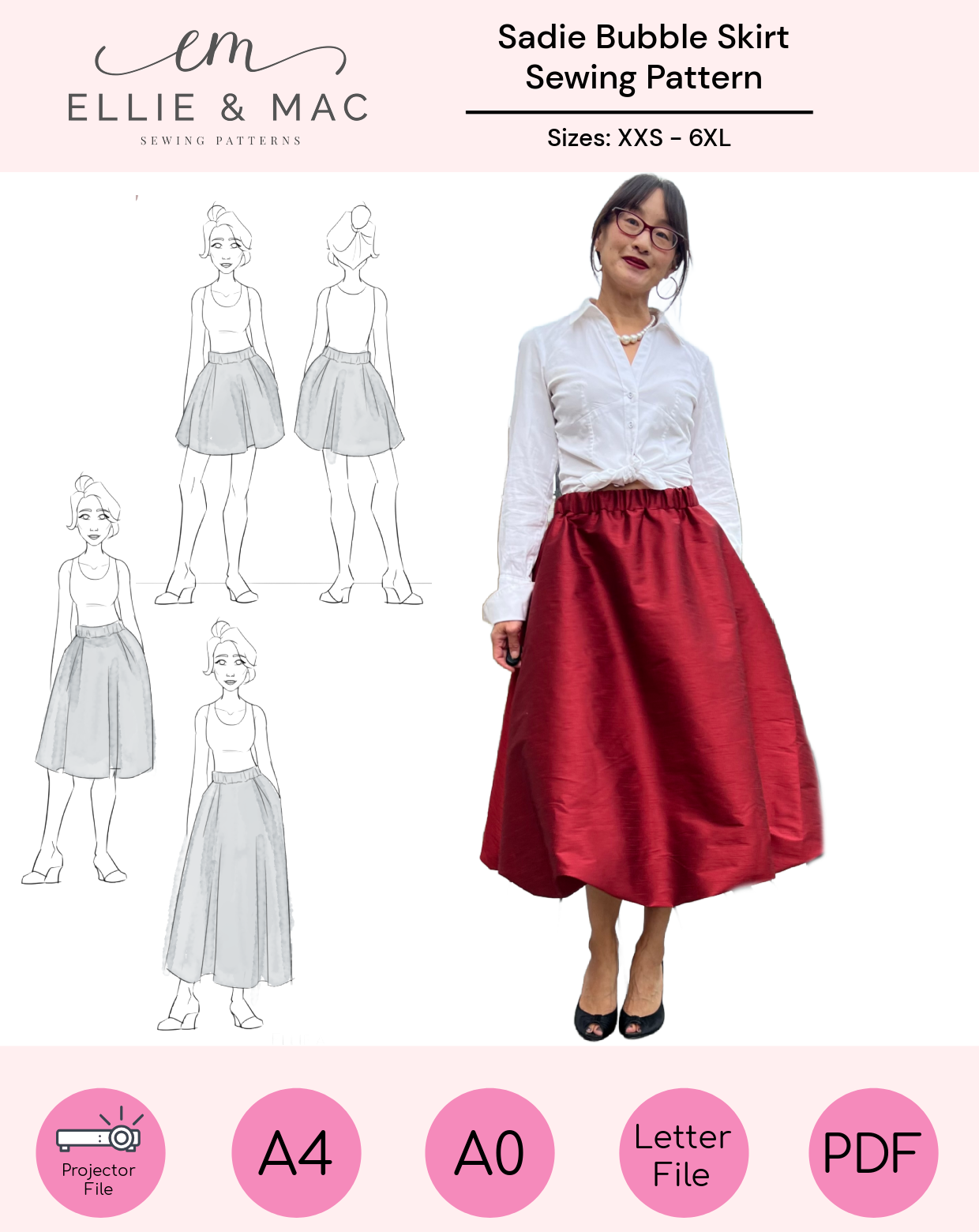GB? UK? WTH? Sometimes all the sewing terms and acronyms can just read as gibberish; especially when you’re new to sewing. But that’s no reason to give up! I’ve written a blog post to help you decipher just what people are talking about!
Ok, so let’s start with types of fabric. Basically, you have wovens and knits. It’s something to do with how the fabrics are constructed. Seriously, this post is the wrong place to go into detail so I’ll let you research yourself. But to break it down (and remembering there’s no absolute hard and fast rules), generally woven don’t stretch and knits do (except sometimes you get stretch woven. Or knit that barely stretches. Confused yet?!)
Types of knits
CL - Cotton Lycra (Lycra, spandex, elastane: all interchangeable). This is good for dresses, tees, jumpers, trousers. Most things tbh. It can have less drape though, so take that into account.
Patterns I’ve made with CL:
Kid's School Cool Tunic & Dress
DBP: Double Brushed Polyester. As above to good for tees, dresses. It can be used for trousers and jumpers too. It depends on what look you’re going for. Lots of drape. It’s 100% polyester though so personally, I can only wear it about two months a year here in sunny Brisbane as the lack of breathability makes it too hot for me)
Adult's Sunny Days Dress
FT: French Terry. Typically great for jumpers and tracksuit bottoms. It has little loops on the back. But I’ve used it for dresses and tees too and love the finished product!
RS: Rayon Spandex. Generally really light but caution..... it can grow! Meaning it stretches out as the day goes by so a maxi may not be the best option. You really need to stabilise this fabric. 
Everywhere Dress
BL: Bamboo Lycra - one of my personal faves! Like cotton Lycra but has more drape and is great for hot climates. Tees, dresses, rompers. All work well with BL. 
Beatbox Romper
Tres Belle Tunic & Dress
Other lesser used knits (but still great options):
PRS: Poly Rayon Spandex
MVC: Micro Viscose Cotton
VRS: Viscose Rayon Spandex
PUL: Polyurethane Laminate (It’s often used for cloth nappies OR the free Ellie and Mac Snack Bag)
Measuring for Stretch
How to measure for stretch - grab 10 cm of your fabric. Place it against a ruler at 0. Stretch it out. See how far it stretches. This tells you the stretch %. If it stretches by 3cm, it has 30% stretch. If it stretches by 5cm, it has 50% stretch. If it..... you get the gist. Our patterns include stretch test instructions like this: 
Alteration Abbreviations
FBA 1 - Full Bust Adjustment (https://www.ellieandmac.com/blogs/blog/full-bust-adjustments-the-when-and-how-to)
FBA 2 - Full Bicep Adjustment (https://www.ellieandmac.com/blogs/blog/how-to-do-a-full-bicep-adjustment)
FTA - Full Tummy Adjustment (https://www.ellieandmac.com/blogs/blog/full-tummy-adjustment-tutorial)
SBA - Small Bust Adjustment (the opposite of the Full Bust Adjustment)
Sway Back Adjustment - when your spine curves in. Google it. Lots of women need sway back adjustments and they’re easy to do. (https://www.ellieandmac.com/blogs/blog/how-to-do-a-sway-back-adjustment)
SWA - Side Waist Adjustment (https://www.ellieandmac.com/blogs/blog/how-to-do-a-sidewaist-adjustment-for-the-womens-romper)
General Sewing Glossary
Baste - temporary stitch to hold things in place. It’s a straight stitch and normally the longest you can do on your machine (so 5 in my case). It’s often removed after you finish the garment too.
Cut on bias - Bias cut means to 'be cut on the grain'. Rather than following the straight line of the weave, the bias cut places the pattern at a 45° angle on the woven fabric. At this angle, the 'warp' and 'weft' threads give the fabric more of an elastic 'stretch. The grainline runs parallel to the selvage.
Cut on the fold - fold your fabric over. Place the pattern piece on top and have the wording “fold” jutted up against the fold in the fabric you created.
Cut on the double fold - fold the fabric like a towel (video on cutting on double fold: https://youtu.be/3jBeU_SPqWY)
Darts - darts are a v shape sewn into an item of clothing to create shape (and either more or less room given its location).
Gathering stitch - so many ways to do this. It’s basically a row of stitches (or two or three) that’s used to “gather” the fabric.
Seam allowance vs hem allowance. Seam allowance (or SA) is the measurement you use to determine where to run your stitches. For example, a 1/4” SA means you stitch 1/4” away from the edge of the fabric. A hem allowance is the same except it’s for hemming your sleeves or waist. The hem allowance is often greater than the seam allowance because if it’s not deep enough, the hem will often flip whilst wearing it.
Grading - Grading, or pattern grading, is the process of creating a range of sizes for a single apparel style. The purpose of grading is to properly fit a pattern to a range of sizes. Grading will not create shape, but will only increase or decrease size of original shape. (Grading for kid's patterns: https://www.ellieandmac.com/blogs/blog/pattern-grading-sos, grading for adult patterns: https://www.ellieandmac.com/blogs/blog/pattern-grading-sos-part-2-grading-adults-pants-hoodie).
Interfacing - used to provide structure or support to a garment ie along a placket where buttonholes will sit.
Mirrored - meaning you want two pieces that are mirrors of each other. You have two choices here. Either cut your pattern piece on the fold OR flip the pattern piece over. If you ignore this instruction, you’ll end up with two right legs or two left sleeves etc. oh..... and don’t believe an experienced sewist who claim they’ve never done this. We’ve all done this.
Muslin/toile - this one can be confusing because fabric stores sell Muslin. This is basically a cheap cloth. This is NOT what is meant by the term “do a Muslin” or “make a Muslin” (which is why I use the term toile). Making a muslin is doing a practise run to check for fit etc. it needs to be done using a cheap fabric with THE SAME CONSISTENCY as your main fabric. Same weight. Same stretch etc. otherwise a muslin is pointless.
Negative Ease: this means the pattern has been drafted to be smaller than the person wearing it but will stretch to fit. Eg chest is 52cm but pattern is 49cm. This is why it is so important to follow the guidelines for stretch requirements in the pattern. If you use a fabric with only horizontal stretch but no vertical stretch, then that dress is not going to fit as it should. Ask me how I know  (I actually made this mistake with a tulip dress in testing. Did it again with the right fabric and it actually fit like it was supposed to).
(I actually made this mistake with a tulip dress in testing. Did it again with the right fabric and it actually fit like it was supposed to).
Pleats - a double or multiple fold in a garment or other item made of cloth, held by stitching the top or side.
Right sides together (RST) - this is easiest with printed fabric where the reverse side is plain white! But even with a solid it’s the same theory. Find the right side of your fabric on both pieces and place them so they’re touching each other.
Stabiliser - stops an item from stretching out. Clear elastic is often used at a 1:1 ratio BUT be warned, I hate clear elastic. With a passion. I can never get it to sit nicely. Or do what I want. So I just pretend it doesn’t exist. And use regular elastic instead. And it’s always worked fine for me. Here’s a sunny day dress I did with regular elastic instead of clear to stabilise.
Wof - width of fabric. Ellie & Mac Pattern usually base the yardage on 60" WOF for knit fabric and 44" WOF for woven fabrics.
Wrong sides together (WST) - see RST. It’s the opposite.
Stitches
Backstitch - go back and forth a couple of stitches at the start and end of a seam. It stops the stitches coming undone.
Understitch - stops the facing from flipping and showing. You press the Seam Allowance and facing away and sew approx 1/8” from the seam.
Overstitch - done over a seam to stop it unravelling. I just use my overlocker.
Topstitch - a topstitch is done after construction. Sometimes it’s decorative (check out the fancy top stitching done on lots of activewear leggings), sometimes it’s functional (keeps seams sitting where they are supposed to).
Staystitch - used on curves to stop the fabric stretching. Mostly used on necklines with woven fabric. It’s hidden (or at least it should be), once you do your permanent stitches.
In addition to this, our sewing patterns contain a Sewing Glossery in the instructions:
(Written by: Ali Gadsby)
Disclaimer: this post includes aff links. Basically, you pay the same price anyway, but I earn a little commission. If this blog post was helpful to you, I’d love it if you used my aff link to purchase your Ellie and Mac patterns.



















